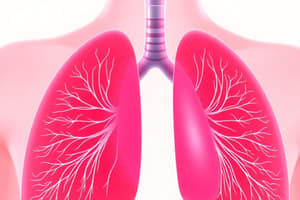Podcast
Questions and Answers
What is the formula for calculating Inspiratory Capacity (IC)?
What is the formula for calculating Inspiratory Capacity (IC)?
- IC = TV + VC
- IC = TV + IRV (correct)
- IC = TV + ERV
- IC = VC + RV
Total Lung Capacity (TLC) includes the Residual Volume (RV).
Total Lung Capacity (TLC) includes the Residual Volume (RV).
True (A)
What does Vital Capacity (VC) represent?
What does Vital Capacity (VC) represent?
maximum volume of air expelled after deepest inspiration
The maximum volume of air that can be expired after normal tidal inspiration is called ___.
The maximum volume of air that can be expired after normal tidal inspiration is called ___.
Match the following terms with their correct definitions:
Match the following terms with their correct definitions:
What is the volume of air inspired or expired during normal quiet breathing?
What is the volume of air inspired or expired during normal quiet breathing?
The residual volume (RV) can be fully exhaled during forced expiration.
The residual volume (RV) can be fully exhaled during forced expiration.
What is the main purpose of pulmonary ventilation?
What is the main purpose of pulmonary ventilation?
The volume of air that can be inhaled forcefully after a normal tidal breath is called ___.
The volume of air that can be inhaled forcefully after a normal tidal breath is called ___.
Match the following lung volumes with their definitions:
Match the following lung volumes with their definitions:
Which lung volume represents air that cannot be forcibly exhaled?
Which lung volume represents air that cannot be forcibly exhaled?
During gas exchange, oxygen is transferred from the blood to the lungs.
During gas exchange, oxygen is transferred from the blood to the lungs.
How does exercise affect lung volumes and capacities?
How does exercise affect lung volumes and capacities?
Flashcards are hidden until you start studying
Study Notes
Respiration
- Involves three steps:
- Pulmonary Ventilation (breathing)
- Movement of air in and out of lungs
- Requires pressure gradients between the outside of the body and the alveoli
- Gas Exchange
- Diffusion of gases
- External respiration: between air in lungs and blood in alveoli
- Internal respiration: between blood & other tissues
- Gas Transport
- Transport of O2 & CO2 in the blood, between alveolar capillaries and capillary beds in other tissues
- Pulmonary Ventilation (breathing)
Lung Volumes
- Measured with a spirometer
- The maximum volume a lung can expand can be divided into four non-overlapping volumes:
- Tidal Volume (TV)
- Volume of air inspired or expired with each breath during normal quiet breathing
- Approximately 500 ml
- Inspiratory Reserve Volume (IRV)
- Extra volume of air that can be inhaled by a maximum inspiratory effort over and above the normal tidal volume
- Approximately 3000 ml
- Expiratory Reserve Volume (ERV)
- Extra volume of air that can be exhaled by a maximum forceful expiration over and above the normal tidal volume
- Approximately 1000 ml
- Residual Volume (RV)
- Volume of air that remains in the lungs after the most forceful expiration
- Approximately 1200 ml
- Minimal volume is a component of residual volume
- Tidal Volume (TV)
Lung Capacities
- Combinations of two or more lung volumes:
- Inspiratory Capacity (IC)
- Maximum volume of air that can be inspired after normal tidal expiration
- IC = TV + IRV = 3500 ml
- Expiratory Capacity (EC)
- Maximum volume of air that can be expired after normal tidal inspiration
- EC = TV + ERV = 1500 ml
- Vital Capacity (VC)
- Maximum volume of air that a person can expel after the deepest possible inspiration
- VC = TV + IRV + ERV = 4500 ml
- Depends on factors like:
- Size of thoracic cavity
- Age
- Strength of respiratory muscles
- Gravity
- Pregnancy
- Pulmonary diseases
- Total Lung Capacity (TLC)
- Volume of air present in the lungs after maximal inspiration
- TLC = VC + RV = 5700 ml
- Inspiratory Capacity (IC)
Spirometer
- Measures the rate at which the lung changes volume
Studying That Suits You
Use AI to generate personalized quizzes and flashcards to suit your learning preferences.




